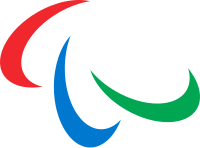
Photo from wikipedia
Cerebral palsy (CP) football is a team para-sport practiced by para-athletes with eligible impairments of hypertonia, athetosis, and ataxia. This study aimed: (1) to describe the anthropometrical and body composition… Click to show full abstract
Cerebral palsy (CP) football is a team para-sport practiced by para-athletes with eligible impairments of hypertonia, athetosis, and ataxia. This study aimed: (1) to describe the anthropometrical and body composition profiles of international CP para-footballers with different CP profiles (i.e., spastic diplegia, athetosis/ataxia, spastic hemiplegia, and minimum impairment); (2) to analyze the differences between both affected/nondominant and nonaffected/dominant sides; and (3) to compare the sample of international-level CP para-footballers (n = 141) with a sample of highly trained able-bodied footballers (n = 39). Anthropometric measures included four breadths, nine girths, and six skinfolds, while body composition was measured through fat mass (including Carter’s, Faulkner’s, and Withers’ equations), muscle mass (Lee’s equation), and bone mass (Rocha’s and Martin’s equations). This study found differences between the able-bodied footballers and the following impairment profiles: spastic diplegia (skinfolds); ataxia/athetosis (corrected calf of the nondominant side, and calf skinfolds for both sides); and spastic hemiplegia (all measurements excepting femur breadth, and thigh and ankle girths). No differences were found between para-athletes with minimum impairment and the able-bodied footballers. This study demonstrates that football players with or without physical impairments of hypertonia athetosis or ataxia may be considered homogeneous in shape when dominant size is compared. Besides, the study provides reference scores on anthropometric measures and body composition of international-level CP para-footballers that can help sports coaches and physical trainers to monitor physical fitness of their para-athletes.
Journal Title: International Journal of Environmental Research and Public Health
Year Published: 2020
Link to full text (if available)
Share on Social Media: Sign Up to like & get
recommendations!